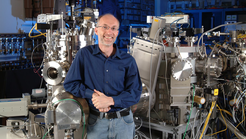Financial Times Magazine - Electronics: Memory Man
British physicist Stuart Parkin believes he could hugely increase data-storage capacity using a new technique called ‘racetrack memory’
As the inventor of a magnetic technology that has led to a thousandfold expansion in the capacity of computer disk drives, Stuart Parkin has already done as much as any other individual for our ability to store vast amounts of digital information. But Parkin, a British physicist working in the US and Germany, believes he could contribute another huge increase in data-storage capacity based on a new technique called “racetrack memory”. Parkin won the 2014 Millennium Technology Prize worth €1m for his work in the late 1980s and 1990s, exploiting the emerging science of “spintronics” to develop the type of magnetic storage that underpins the 21st-century computing infrastructure of data centres, cloud services, social networks and online entertainment.

While magnetic hard drives using spintronics can hold vast amounts of data, they rely on rotating disks and moving read/write heads that make them intrinsically slower, more energy-intensive and less reliable than the industry would like. Alternative non-moving memories such as solid-state chips and flash memories have their uses but lack the speed and integrity required for rapid access mass data storage. Which is where the racetrack comes in: a technology that could be cheap, fast, reliable, durable and low-energy. Since Parkin proposed the racetrack in 2002, he has been working with colleagues at IBM and elsewhere to make it a reality. He says: “It could become a commercial product within five to seven years.” Racetrack technology also uses spintronics but in a compact form that does not require an electricity supply to maintain the data; it stores digital bits as tiny magnetised regions on nanowires – the racetracks. While all storage devices today hold data on 2D disks or chips, the racetrack memory is a 3D device with the nanowires constructed as vertical columns rising like a forest from a silicon chip. “Building in three dimensions gives us a huge increase in storage density,” Parkin says. “We can increase memory capacity by another thousandfold without increasing cost.”
The magnetised regions race back and forth along their tracks past nanoscale read/write heads. The key difference from today’s disc drives is that the magnetic medium itself does not move. Instead the bits themselves travel past the heads, driven by a tiny electric current, greatly reducing the energy required to operate the device. When the power is off, the magnetic domains can retain their spin state indefinitely. The racetrack is not Parkin’s only contender for the future of computer storage. He is also pursuing other technologies, such as strange particle-like magnetic swirls called “skyrmions”. If he succeeds again we may look back from the late 2020s and hail him as the man who improved data storage a millionfold. | Text © Clive Cookson
